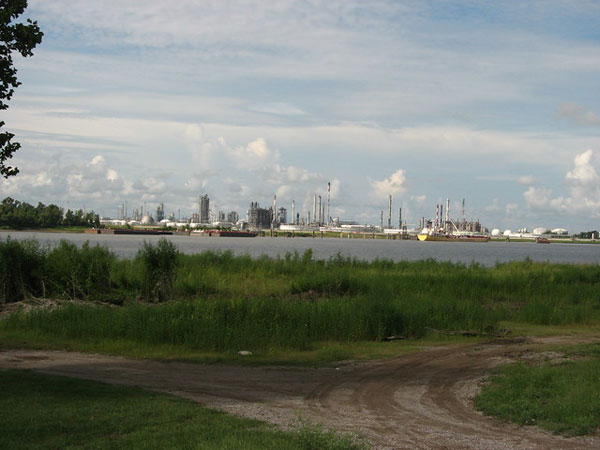
May 6, 2019; Colorlines
When industry comes to a new location, many talk only about the jobs it will bring. However, when the impact on the lives and well-being of the residents is taken into account, the picture may look more dangerous—even fatal.
Robert Taylor, a 77-year-old environmental activist in the Southern Louisiana Parish of John the Baptist, has had enough of the smoke and mirrors coming from petrochemical companies and the state’s environmental protection agency. While both of these entities continue to put out statements amounting to “all is well,” Taylor, who last year appeared in a video called “Breathing While Black,” is organizing his neighbors and helping to spearhead a media campaign to spread the word about what’s really happening in his town of Reserve.
“Putting up signs is one of the steps we are taking, so that later no one can say they didn’t know we are being poisoned,” he said.
Taylor and other residents of “Cancer Alley” are protesting the unregulated pollution going on in this 85-mile stretch of Louisiana, which has the highest concentration of oil, natural gas, and petrochemical facilities in the Western hemisphere. (The stretch is so well associated with cancer that it has its own Wikipedia page.) The region also has cancer rates that reach 700 times the national average and a high concentration of other health issues such as liver and kidney problems. Residents argue, with good scientific reason, that the chemical plants in the area produce emissions that endanger their families and ought to be more tightly regulated. According to Colorlines, “In December 2015, the US Environmental Protection Agency (EPA) confirmed that Reserve [a town in Cancer Alley] has the most polluted air in the region,” and “nearly every household has had someone die from cancer.”
Nearly every outlet covering the story (and there are many) notes two things: In 2015, the federal Environmental Protection Agency did a study of air quality in the region and found that Cancer Alley had an elevated risk of cancer; and in May 2016, an EPA memo found that chloroprene—a main ingredient in neoprene, the product of a factory near Reserve—is “likely carcinogenic to humans.” An administrative order on consent agreed that Denka Performance Elastomer, the company producing the neoprene, would reduce chloroprene emissions by 85 percent, even as the company contested the EPA’s findings about the safety levels of chemical concentrations and air quality in the towns.
The company, while moving to comply with the consent order from 2015, contests the basic premise of Taylor’s cause. “[Denka] operates its facility safely and within all permits written by the Louisiana department of environmental quality in accordance with existing standards designed to protect public health and the environment,” said a spokesperson. That might be true, but all it means is that extant standards are inadequate.
Sign up for our free newsletters
Subscribe to NPQ's newsletters to have our top stories delivered directly to your inbox.
By signing up, you agree to our privacy policy and terms of use, and to receive messages from NPQ and our partners.
“The petrochemical industry and human beings cannot live and operate side by side,” Taylor says. “So they have decided they’re okay with just wiping us out, especially because of the fact that this is a poor Black population. We were the lowest-hanging fruit.”
Public officials are not being much help, despite the strong conclusions of the EPA’s prior studies. Chuck Carr Brown, the secretary of Louisiana’s Department of Environmental Quality, told CNN, “It’s not like there’s a smoking gun somewhere in St. John Parish.” The federal EPA told CNN that their primary concern was not the level of emissions at any given moment, but exposure over a lifetime. A spokesperson said, “If the concentrations were to persist at current levels for a lifetime, there is potential for adverse health effects. This is why EPA and the state are working with Denka to reduce emissions.” But it has persisted over many people’s lifetimes, in a region that already has a legacy of exploitation and repression. “First slavery, then sharecropping, now this. It’s just a new way of doing it,” said Mary Hampton, an 80-year-old Cancer Alley resident and a co-organizer with Taylor of Concerned Citizens Of St John.
Resident Geraldine Watkins asked, “Industry is wonderful to have, but if it’s killing the people in the area that they live in, what good is industry?” Mary Hampton adds, “I still can’t believe that this one community could be asked to suffer this much, merely for the profit of these foreign corporations. What kind of people are they to knowingly wipe out a whole community of people for profit?” Last June, residents filed a lawsuit against the plant to force them to comply with the EPA’s emissions standard, which is up to 30 times lower than the levels found in some of the monitoring stations’ readings in recent years.
A recent report from PNAS (Proceedings of the National Academy of Sciences) hypothesized that air pollution is, as National Public Radio reports, “disproportionately caused by White Americans’ consumption of goods and services, but disproportionately inhaled by Black and [Latinx] Americans.”
NPQ has discussed how people of color disproportionately face poor environmental conditions, and while many groups such as Concerned Citizens Of St. John’s operate in their communities, they often don’t have the relationship to big philanthropy that would give them leverage with an organization like the state EPA.
This week, The Guardian is running a series on Cancer Alley, Concerned Citizens, and the fight of a small community against a large company determined to overwrite the truth about the costs of their production.—Erin Rubin













